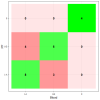PRRS Monitoring by Processing Fluids on Italian Swine Breeding Farms
- PMID: 37370456
- PMCID: PMC10295118
- DOI: 10.3390/ani13121946
PRRS Monitoring by Processing Fluids on Italian Swine Breeding Farms
Abstract
The porcine reproductive and respiratory syndrome (PRRS) control strategy within swine breeding farms is based on herd classification relative to PRRSV infection status. This study aims to assess the efficacy of a monitoring plan based on processing fluids (PFs) by comparing it with the classification of herds based on the analysis of blood serum. Twenty-five breeding herds were enrolled in the study, with at least five consecutive batches sampled from each herd. Each batch was tested for PRRSV by RT-PCR performed on (i) pre-weaning blood serum from 30 piglets and (ii) PFs from all the male piglets in the batch. PRRS categories following the Holtkamp classification were assigned based on the results of each testing protocol. The two protocols assigned the same category to 18 out of 25 herds: while they showed perfect agreement in identifying positive unstable and stable herds, we observed some discrepancy in discriminating between low- and high-prevalence classes within unstable herds. PFs are thus a reliable sample to assign PRRS categories in Italian breeding herds characterized by widespread PRRSV circulation. However, in case of an unstable epidemiological scenario, we recommend the adoption of an integrated monitoring strategy that combines blood sampling with PFs.
Keywords: PRRSV; disease surveillance; herd classification; pigs; porcine reproductive and respiratory syndrome; processing fluids.
Conflict of interest statement
We declare that Simone Andreoni is employed by Boheringer Ingelheim AH S.p.A. Boheringer Ingelheim AH S.p.A. had no role in the design of the study, in the collection, analysis, or interpretation of the data; in the writing of the manuscript; or in the decision to publish the results.
Figures
References
-
- Zimmerman J.J., Dee S.A., Holtkamp D.J., Murtaugh M.P., Stadejek T., Stevenson G.W., Torremorell M., Yang H., Zhang J. Diseases of Swine. John Wiley & Sons, Ltd.; Hoboken, NJ, USA: 2019. Porcine Reproductive and Respiratory Syndrome Viruses (Porcine Arteriviruses) pp. 685–708.
LinkOut - more resources
Full Text Sources


